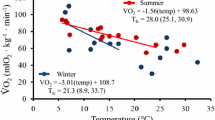Summary
Metabolic rates by means of oxygen consumption (VO2) at various ambient temperatures (T a) and food consumption as well as water intake and thermoregulation were compared between individuals of the Cape porcupine Hystrix africaeaustralis acclimated to T a=32°C with a photoperiod of 16L:8D summer-acclimated and T a=10°C; 8L:16D winter-acclimated. The lower critical temperature as well as overall minimal thermal conductance were lower for the winter-acclimated porcupines when compared to summer-acclimated ones, while VO2 at the thermoneutral-zone was significantly (P<0.001) higher in the winter-acclimated porcupines. Dry matter intake, apparent digestible dry matter intake, gross digestible energy intake, as well as water intake, were significantly higher in the winter-acclimated porcupines. Yet, while dry matter intake increased 4 times in the winter-acclimated porcupines, apparent digestible dry matter increased only at a rate of 2.9 times. This difference is better reflected in terms of digestibility efficiency which in the winter-acclimated porcupines is only at a rate of 67.5% while in the summer-acclimated porcupines it is at a rate of 90%. From the results of this study, it is possible to assume that heat production in the winter-acclimated porcupines is partly increased by food intake. Increased heat production on the one hand, and a decrease in overall minimal thermal conductance on the other, seem to be important mechanisms in winter acclimatization of the Cape porcupine.
Similar content being viewed by others
References
Alkon PU, Degen AA, Cohen A, Pollak H (1986) Seasonal energy requirements and water intake of Indian crested porcupines (Hystrix indica) in captivity. J Mamm 67:333–342
Bradley SR, Deavers DR (1980) A re-examination of relationship between thermal conductance and body weight in mammals. Comp Biochem Physiol 65A:465–476
Cygan T (1985) Seasonal changes in thermoregulation and maximum metabolism in the yellow-necked field mouse. Acta Theriol 30:115–130
De Graaff G (1981) The Rodents of Southern-Africa. Butter-worths, Pretoria, pp 49–53
Depocas F, Hart JS (1957) Use of the Pauling oxygen analyzer for measurements of oxygen consumption of animals in open circuit system and in short lag, closed circuit apparatus. J Appl Physiol 20:388–392
Feist DD, Fiest CF (1986) Effects of cold, short day and melatonin on thermoregulation, body weight and reproductive organs in Alasken red-backed voles. J Comp Physiol B 156:741–746
Haim A, Ashkenazi R, Kalir A (1983) Long scotophase acclimation increases free urinary catecholamine content in the rat. Comp Biochem Physiol 74C:323–324
Hart JS (1971) Rodents. In: Whittow CG (ed) Comparative physiology of thermoregulation, vol II. Academic Press, New-York, pp 1–149
Heldmaier G, Boeckler H, Buchberger A, Klaus S, Puchalski S, Steinlechner S, Wiesinger H (1986) Seasonal variation of thermogenesis. In: Heller et al. (eds) Living in the cold: Physiology and biochemical adaptations. Elsevier Science Publication, Amsterdam, pp 361–372
Hill RW (1972) Determination of oxygen consumption by use of the paramagnetic oxygen analyzer. J Appl Physiol 33:261–263
Himms-Hagen J (1967) Sympathetic regulation of metabolism. Pharmacol Rev 19:367–461
Jansky L (1973) Non-shivering thermogenesis and its thermoregulatory significance. Biol Rev 48:85–132
Kleiber M (1961) The fire of life. Wiley, New-York. Chap 10, pp 177–216
Rosenmann M, Morrison P, Fiest DD (1975) Seasonal changes in the metabolic capacity of red-backed voles. Physiol Zool 48:303–310
Rothwell NJ, Stock MJ (1979) A role for brown adipose tissue in diet-induced thermogenesis. Nature 281:31–35
Skinner JD, Van Aarde JR, Van Jaarsveld AS (1984) Adaptations in three species of large mammals (Antidorcas marsupialis, Hystrix africaeaustralis, Hyaena brunnea) to arid environments. S Afr J Zool 19:82–86
Smithers RHN (1983) The mammals of the Southern-Africa subregion. University of Pretoria, Pretoria, pp 186–188
Webster AJF (1974) Adaptation to cold. In: Robertshaw D (ed) MTP International review of science, physiology, seri 1, vol 7 (Environmental physiology). Butterworths, London pp 71–107
Webster AJF (1981) The energetic efficiency of metabolism. Proc Nutr Soc 40:121–128
Author information
Authors and Affiliations
Rights and permissions
About this article
Cite this article
Haim, A., Van Aarde, R.J. & Skinner, J.D. Metabolic rates, food consumption and thermoregulation in seasonal acclimatization of the Cape porcupine Hystrix africaeaustralis . Oecologia 83, 197–200 (1990). https://doi.org/10.1007/BF00317752
Received:
Accepted:
Issue Date:
DOI: https://doi.org/10.1007/BF00317752




